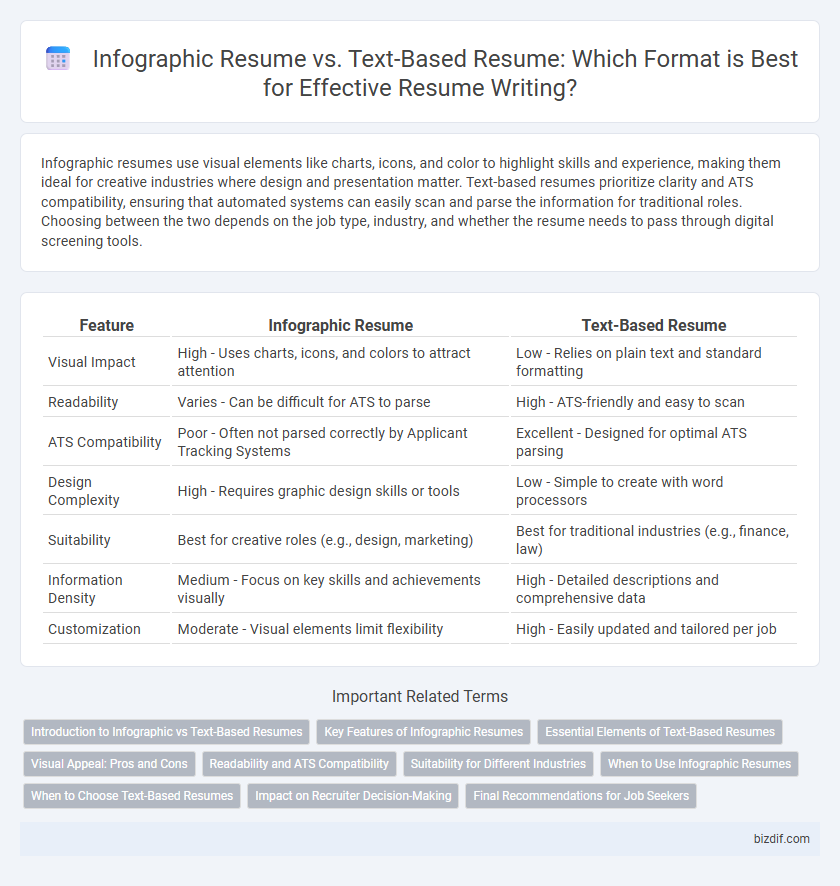Infographic resumes use visual elements like charts, icons, and color to highlight skills and experience, making them ideal for creative industries where design and presentation matter. Text-based resumes prioritize clarity and ATS compatibility, ensuring that automated systems can easily scan and parse the information for traditional roles. Choosing between the two depends on the job type, industry, and whether the resume needs to pass through digital screening tools.
Table of Comparison
| Feature | Infographic Resume | Text-Based Resume |
|---|---|---|
| Visual Impact | High - Uses charts, icons, and colors to attract attention | Low - Relies on plain text and standard formatting |
| Readability | Varies - Can be difficult for ATS to parse | High - ATS-friendly and easy to scan |
| ATS Compatibility | Poor - Often not parsed correctly by Applicant Tracking Systems | Excellent - Designed for optimal ATS parsing |
| Design Complexity | High - Requires graphic design skills or tools | Low - Simple to create with word processors |
| Suitability | Best for creative roles (e.g., design, marketing) | Best for traditional industries (e.g., finance, law) |
| Information Density | Medium - Focus on key skills and achievements visually | High - Detailed descriptions and comprehensive data |
| Customization | Moderate - Visual elements limit flexibility | High - Easily updated and tailored per job |
Introduction to Infographic vs Text-Based Resumes
Infographic resumes use visual elements such as charts, icons, and color schemes to present skills and experiences, enhancing readability and engagement for creative roles. Text-based resumes rely on structured, concise language with clear headings and bullet points, prioritizing straightforward information delivery and compatibility with applicant tracking systems (ATS). Choosing between infographic and text-based resumes depends on the industry, job requirements, and the need for visual appeal versus ATS optimization.
Key Features of Infographic Resumes
Infographic resumes utilize visual elements such as icons, charts, and color schemes to highlight skills, experience, and achievements, making information more digestible and engaging for recruiters. They often incorporate timelines to illustrate career progression and skill proficiency levels through graphs, enhancing quick comprehension. This format is especially effective in creative industries, where design and presentation can convey personal branding and creativity alongside professional qualifications.
Essential Elements of Text-Based Resumes
Text-based resumes prioritize clear, concise contact information, a strong professional summary, and detailed work experience with quantifiable achievements. They emphasize standardized formatting, including consistent font styles and bullet points, to enhance readability and applicant tracking system (ATS) compatibility. Keywords aligned with the job description and clear section headings are essential for optimizing visibility in digital recruitment processes.
Visual Appeal: Pros and Cons
Infographic resumes enhance visual appeal by using graphics, colors, and charts to highlight key skills and achievements, making them ideal for creative industries and catching recruiters' attention quickly. Text-based resumes provide a clean, straightforward format preferred by applicant tracking systems (ATS) and traditional employers, ensuring compatibility and readability. However, infographic resumes may struggle with ATS parsing, while text-based resumes can lack visual engagement and fail to stand out in competitive job markets.
Readability and ATS Compatibility
Infographic resumes enhance readability through visual elements like charts and icons but often struggle with Applicant Tracking System (ATS) compatibility, leading to potential parsing errors. Text-based resumes prioritize ATS optimization by using standard formatting and keywords, ensuring higher chances of passing automated screenings. Balancing visual appeal and ATS friendliness is crucial when choosing between infographic and text-based resume formats.
Suitability for Different Industries
Infographic resumes excel in creative industries such as marketing, design, and advertising where visual storytelling highlights skills effectively. Text-based resumes remain the standard in traditional fields like law, finance, and healthcare, emphasizing clarity and straightforward information presentation. Choosing the right resume format depends on industry expectations and the nature of the job role.
When to Use Infographic Resumes
Infographic resumes are ideal for creative industries such as design, marketing, and advertising where visual presentation can showcase skills effectively. They help candidates highlight achievements using graphics, charts, and icons, making complex data easy to interpret at a glance. However, infographic resumes should be used when applying to companies that value innovation and creativity, whereas text-based resumes remain preferred in traditional sectors like finance, law, and healthcare.
When to Choose Text-Based Resumes
Text-based resumes are ideal for professional industries such as finance, law, and healthcare where applicant tracking systems (ATS) play a crucial role in initial candidate screening. These resumes ensure compatibility with ATS by using straightforward formatting, enabling effective keyword scanning and higher chances of reaching hiring managers. Opt for text-based resumes when applying to traditional companies or large corporations that prioritize detailed, structured information over visual design elements.
Impact on Recruiter Decision-Making
Infographic resumes enhance recruiter decision-making by presenting key skills and achievements visually, enabling faster comprehension and stronger engagement compared to traditional text-based resumes. Text-based resumes provide detailed information and are favored in Applicant Tracking System (ATS) scans, ensuring recruiter access to precise data but potentially slowing initial impression formation. Balancing visual appeal with content clarity significantly impacts recruiter preference and improves the likelihood of advancing in competitive hiring processes.
Final Recommendations for Job Seekers
Job seekers should choose an infographic resume when applying to creative industries where visual skills are valued, as it highlights design abilities and captures attention quickly. For traditional sectors such as finance, law, or administration, a text-based resume ensures clarity, ATS compatibility, and professionalism. Tailoring the resume format to the job's requirements and company culture maximizes the chances of passing initial screenings and impressing hiring managers.
Infographic Resume vs Text-Based Resume Infographic

 bizdif.com
bizdif.com